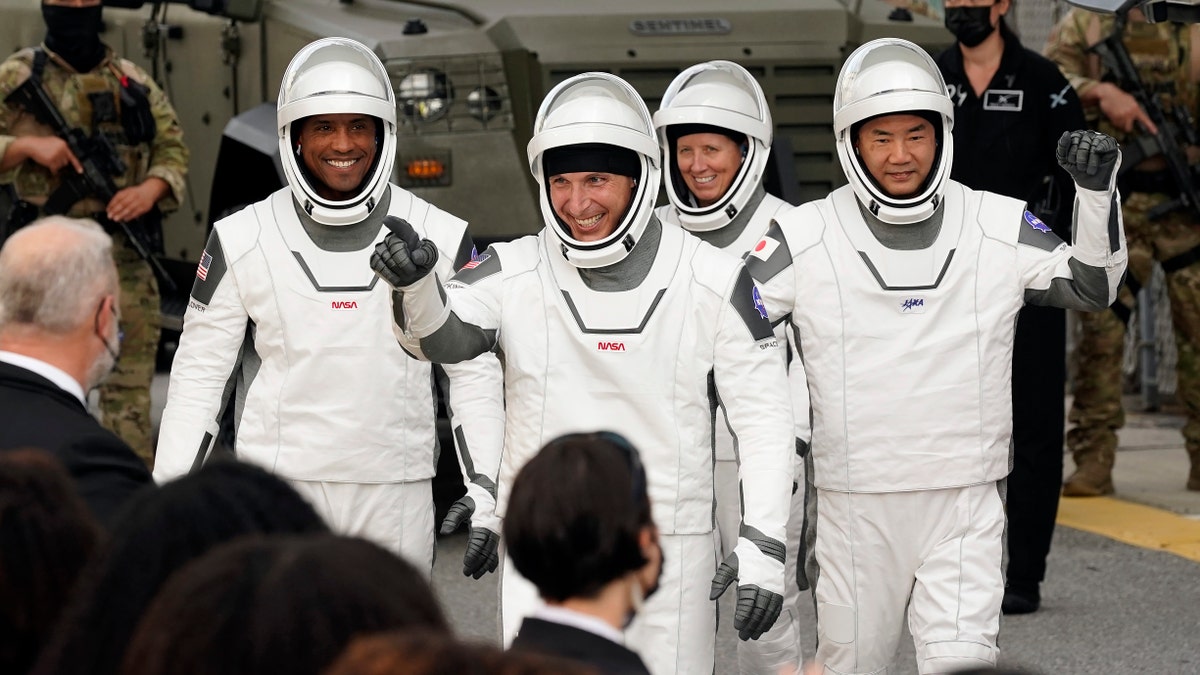SpaceX Crew-1 successfully launches en route to ISS
The SpaceX Crew-1 successfully launched from Kennedy Space Center en route to the International Space Station Sunday night.
NASA has made its first operational SpaceX Crew Dragon launch, marking an important milestone for the space program.
The SpaceX Falcon 9 rocket carrying the Crew Dragon spacecraft lifted off from Launch Complex 39A at NASA’s Kennedy Space Center in Florida at 7:27 p.m. ET Sunday. Shortly after launch, the first-stage booster rocket separated from Crew Dragon. It touched down on a drone ship floating in the Atlantic Ocean about 10 minutes after liftoff.
The Crew Dragon spacecraft, which was named Resilience by the crew, will reach the International Space Station around 11 p.m. ET Monday.
"Resilience rises," tweeted NASA at liftoff.
The six-month mission is the first crew rotation flight on a U.S. commercial spacecraft.
"A great launch!," tweeted President Donald Trump. "@NASA was a closed up disaster when we took over. Now it is again the 'hottest', most advanced, space center in the world, by far."
President-elect Joe Biden tweeted his congratulations to NASA and SpaceX following the launch. "It’s a testament to the power of science and what we can accomplish by harnessing our innovation, ingenuity, and determination," he wrote. "I join all Americans and the people of Japan in wishing the astronauts Godspeed on their journey."
The Crew-1 mission is transporting NASA astronauts Mike Hopkins, Victor Glover and Shannon Walker and Japan Aerospace Exploration Agency astronaut Soichi Noguchi to the International Space Station aboard the Crew Dragon vehicle. It follows a successful Demo-2 mission earlier this year.
“Godspeed Crew-1!” tweeted NASA Administrator Jim Bridenstine a few hours before launch. The NASA chief also tweeted a selfie with the four astronauts.
NASA HAS CERTIFIED ELON MUSK'S SPACEX TO CARRY ASTRONAUTS, ENDING ITS RELIANCE ON RUSSIA
The launch was pushed back from Saturday on account of the weather.

Astronauts, from left, Victor Glover, Michael Hopkins, Shannon Walker, and Japan Aerospace Exploration Agency astronaut Soichi Noguchi wave to family members as they leave the Operations and Checkout Building for a trip to Launch Pad 39-A and planned liftoff on a SpaceX Falcon 9 rocket with the Crew Dragon capsule on a six-month mission to the International Space Station Sunday, Nov. 15, 2020, at the Kennedy Space Center in Cape Canaveral, Fla. (AP Photo/John Raoux)
Vice President Mike Pence and Second Lady Karen Pence viewed the launch at Kennedy Space Center.
SpaceX CEO Elon Musk, however, was sidelined by COVID-19. On the eve of the launch, Musk disclosed that he “most likely” has a moderate case of coronavirus, despite mixed results
The NASA astronauts will join their colleague Kate Rubins on the orbiting space lab, where they will conduct a range of scientific research.
Crew-1 marks another important milestone for America’s space program following the Demo-2 flight earlier this year.

A SpaceX Falcon 9 rocket with the company's Crew Dragon spacecraft onboard is seen on the launch pad at Launch Complex 39A as preparations continue for the Crew-1 mission, Sunday, Nov. 15, 2020, at NASA's Kennedy Space Center in Cape Canaveral, Florida. (Joel Kowsky/NASA via AP)
On Aug. 2, NASA astronauts Doug Hurley and Bob Behnken splashed down in the Gulf of Mexico in a SpaceX Crew Dragon spacecraft, ending their historic two-month trip to space.
The mission marked the first time that astronauts have launched from American soil since the final Space Shuttle flight in 2011. Amid a blaze of publicity, the Demo-2 mission lifted off from Kennedy Space Center atop a SpaceX Falcon 9 rocket on May 30.
CLICK HERE TO GET THE FOX NEWS APP
After the end of the Space Shuttle program, the U.S. relied on Russian Soyuz rockets launched from the Baikonur Cosmodrome in Kazakhstan to get astronauts into space. Russia charges the U.S. about $75 million to send an astronaut into space, and the Associated Press reports that the last Soyuz ticket cost America $90 million.
Fox News’ Chris Ciaccia, Kristin Fisher, Lauren Blanchard, David Clark, Erin McEwan and the Associated Press contributed to this article.






















